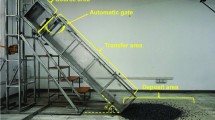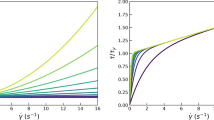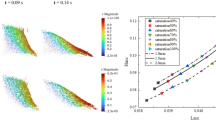Abstract
Landslides and debris flow possess greater damaging power due to their sudden occurrence and relatively high velocity. Landslide flow behaviour can be interpreted using a granular column collapse model. In the present study, dry granular flow behaviour on the erodible and non-erodible layers is analysed. A granular column collapse model with its spreading surface containing an erodible and non-erodible layer is used in this study. The unique property of granular particles to behave in a heterogeneous manner requires its analysis to be done individually. Therefore, particulate-level simulations are performed with the help of the discrete element method (DEM). Particle trajectories and the interaction forces between the particles in the system are studied at every step. Notable changes are found in the flow behaviour with respect to different aspect ratios. Parameters like bulk coordination number and the evolution of energy of the system are taken into consideration in this study.
Access provided by Autonomous University of Puebla. Download conference paper PDF
Similar content being viewed by others
Keywords
1 Introduction
Rock and debris avalanches can travel extremely long distances along flat or almost flat surfaces. The collapse of a granular column is of great interest for studying transient granular flow conditions. Granular column collapse is similar to the well-known dam-break problem in fluid mechanics [1]. Landslides frequently occur along surfaces mantled by a shallow layer or thick deposits made of erodible materials. As a result, entrainment occurs increasing the volume of the failure mass, thereby changing the behaviour and mobility of the flowing mass. Considering these implications, it is hoped to infer the initiation and propagation mechanism of real debris flows with the help of the granular column model proposed by Lajeunesse et al. [2] and Lube et al. [3] in plane strain conditions along a smooth basal surface and an erodible surface.
2 Methodology
The configuration of the numerical model used in this research is based on a granular column collapse model as proposed by Lube et al. [4]. As shown in Fig. 1, a removable gate is placed to control the collapse of the granular column. The walls are provided with the same friction coefficient as that given for the particles. In this way, every particle experiences the same amount of friction. The horizontal base is with and without an erodible bed, where the non-erodible ones have the same roughness as the flowing material (see Figs. 1 and 2). The space enclosed by the removable gate and the nearest wall is packed with granular materials.
A loose granular column is generated within the parallelepiped prism of initial column height (Hi) and initial column width (Li). After the generation of the particles with specified size, gravity is applied to the particles which make the particles settle down by gravity and form a dense granular column similar to the natural deposit. Once the particles are settled down attaining a static state, the gate is released to initiate the collapse. The granular column collapses by flowing along the erodible and non-erodible horizontal floor following both vertical and horizontal movement. When the particles come to rest, the final run-out distance (Lf) covered by the granular deposit and final granular height (Hf) is found for both erodible and non-erodible base conditions. As proposed by Zenit [5], the outermost edge of the deposit is the point where the majority of the flowing materials are in contact with each other. This idea neglects the position of loose materials that are jumping out of the flow.
3 Results and Discussion
In the DEM model, it is necessary to select a representative elementary volume (REV) (Modenese et al. [6]) so that the size of the granular column or the number of grains present in it has a negligible effect on the numerical results obtained. From the implications of Zhao [7], the influence of model size ratio for granular flows is negligible for values greater than 40. By considering this into account, granular columns of model size ratio greater than 40 are taken in this study.
The input parameters involved in this study are given as follows:
-
1.
Initial column height (Hi), m = varies
-
2.
Initial column length (Li), m = 0.5
-
3.
Aspect ratio (a = Hi/Li) = varies
-
4.
Young’s modulus (E), N/m2 = 5 × 107
-
5.
Poisson ratio = 0.4
-
6.
Friction coefficient = 0.6
-
7.
Particle diameter (D), mm = 3
-
8.
Packing porosity (n) = 0.43
-
9.
Particle density (ρ), kg/m3 = 2650
-
10.
Damping coefficient = 0.0
-
11.
Gravity (g), m/s2 = −9.81
-
12.
Time step (Δt), s = 10−5
The main controlling factors are the column geometry described in terms of aspect ratio a, between initial column length (Li) and height (Hi). Simulations are done for four different aspect ratios, each for both erodible and non-erodible conditions. Figures 3 and 4 show the evolution of bulk coordination number with and without erodible beds, respectively. The higher the bulk coordination number, the lower the average velocity of particles in the system and vice versa. This is due to the fact that the bulk coordination number is related to the density of particles in the system.
For the columns of aspect ratio lesser than 3, the evolution of bulk coordination number with respect to the normalized time is gradual for both the erodible and non-erodible conditions. The bulk coordination number values are maintained low in non-erodible cases than that of the erodible condition.
For the columns of aspect ratio greater than 3, the values of bulk coordination number change rapidly in reference to the normalized time for both erodible and non-erodible conditions. Bulk coordination number values in non-erodible bed condition shoot up above the values in erodible bed condition.
In both erodible and non-erodible conditions, a minimum value of bulk coordination number is attained after the removal of the confining gate which symbolizes the occurrence of the maximum kinetic energy of the system. At a normalized time [T] = 0.5, the maximum kinetic energy is attained. For smaller aspect ratio columns, this value is attained after gradual increment, whereas a sharp change is noted in the larger aspect ratio columns. It is due to the fact that the movement of granular particles in smaller aspect ratio columns are governed by the interparticle friction, whereas the inertial property of the particles comes into effect in the case of larger aspect ratio columns. This also confirms the lesser velocity of particles in smaller aspect ratio columns with a greater velocity witnessed in the particles of larger aspect ratio columns.
Figure 5 shows the variation of dissipation energy normalized with the total energy of the system for both erodible and non-erodible bed conditions. The dissipation energy witnessed in non-erodible bed condition is greater than that of the erodible bed condition. Hence, it can be inferred that the majority of the total energy is converted into kinetic energy rather than getting dissipated, thereby causing the final run-out length to increase in erodible bed condition. This also supports the occurrence of maximum kinetic energy in erodible bed condition.
4 Conclusions
From the studies carried out numerically, it has been found that the presence of an erodible layer in the path of the granular flow affects its behaviour, especially for the failure mass originating from the granular columns of larger aspect ratios. The final run-out length of the failure mass changes, due to the increased kinetic energy in response to the presence of an erodible bed.
References
Ritter, A.: Die fortpflanzung der wasserwellen. Zeitschrift des Vereines Deutscher Ingenieure 36(33), 947–954 (1892)
Lajeunesse, E., Monnier, J.B., Homs, G.M.: Granular slumping on a horizontal surface. Phys. Fluids 17(10), 1–16 (2005)
Lube, G., Hippert, H.E., Sparks, R.S.J., Hallworth, M.A.: Axisymmetric collapses of granular columns. J. Fluid Mech. 508, 175–199 (2004)
Lube, G., Huppert, H.E., Stephen, R., Sparks, J., Freundt, A.: Collapses of two-dimensional granular columns. Phys. Rev. E–Statist. Nonlinear Soft Matter Phys. 72(4), (2005)
Zenit, R.: Computer simulations of the collapse of a granular column. Phys. Fluids 17(3), (2005)
Modenese, C., Utili, S., Houlsby, G.T.: A numerical investigation of quasi-static conditions for granular media. Int. Symp. Discrete Element Model. Particul. Media Edit. 187–195, (2012)
Zhao, T.: Coupled DEM-CFD Analyses of Landslide-Induced Debris Flows. Springer Nature, Singapore (2017)
Shi, B., Zhang, Y., Zhang, W.: Analysis of the entire failure process of the rotational slide using the material point method. Int. J. Geomech. 18(8), 04018092 (2018)
Author information
Authors and Affiliations
Editor information
Editors and Affiliations
Rights and permissions
Copyright information
© 2022 The Author(s), under exclusive license to Springer Nature Singapore Pte Ltd.
About this paper
Cite this paper
Sureka, S., Kavinkumar, C., Pillai, R.J. (2022). Study of Dry Granular Flow Behaviour with and Without Erodible Layer. In: Satyanarayana Reddy, C.N.V., Muthukkumaran, K., Vaidya, R. (eds) Stability of Slopes and Underground Excavations. Lecture Notes in Civil Engineering, vol 185. Springer, Singapore. https://doi.org/10.1007/978-981-16-5601-9_11
Download citation
DOI: https://doi.org/10.1007/978-981-16-5601-9_11
Published:
Publisher Name: Springer, Singapore
Print ISBN: 978-981-16-5600-2
Online ISBN: 978-981-16-5601-9
eBook Packages: EngineeringEngineering (R0)









